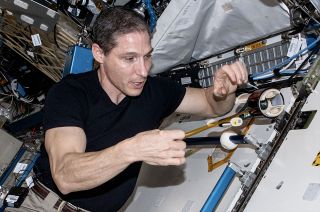NASA taps high school students for space station duct tape dispenser

For more than 50 years, NASA astronauts have relied on duct tape as a fix-it-all for everything from a lunar rover on the moon to an air leak on board the International Space Station. Up until now, though, they have not had an easy way to dispense the adhesive.
Enter high school students from five different states, who have come up with the solution.
SpaceX Crew-1 commander Mike Hopkins, a flight engineer on the space station's Expedition 64 crew, recently demonstrated the HUNCH tape dispenser aboard the orbiting laboratory.
"This tape dispenser I think is going to find a lot of use here on the International Space Station," said Hopkins in a recorded video showing the device in action.
Related: Artist dreams up mock mission to Mars with duct tape in NYC

HUNCH, or High School Students United with NASA to Create Hardware, is a nationwide program that challenges students to design and build equipment that is then launched and used aboard the space station. Now in its 18th year, HUNCH students have built lockers, handrails, various tools and a galley table for the crew to eat at and share meals. The program has even come up with some of the food items that have been added to the astronauts' menus.
This latest project solved a sticky problem for the station's crew.
Get the Space.com Newsletter
Breaking space news, the latest updates on rocket launches, skywatching events and more!
"One of the key things I like about it is you can basically operate it with one hand. Up here, you oftentimes are using your other hand to stabilize yourself," Hopkins said.
Before the HUNCH dispenser, rolls of duct tape — which is also referred to as "grey tape" or "Mach 25 tape" — and Kapton high temperature tape were generally stuck to the edges of work areas, on handrails or wherever in reach. To cut the tape from the roll, the astronauts needed to use scissors or, in a pinch, they tore it with their teeth.
Although crewmembers are able to use off-the-shelf dispensers for Scotch tape, the available commercial solutions for the larger duct and Kapton tape rolls lacked a seat track or other type of connector to be compatible with the station's systems.
"Very easily it goes on the guide rail and you can see it is already locked in place," Hopkins said of the HUNCH dispenser, as he mounted it on one of the walls of the U.S. Destiney lab.
"I can have multiple [types of] tapes on at the same time, so that is also nice," he said.
The HUNCH tape dispenser was developed and built by students at Windsor High School in Windsor, Connecticut; Lakewood High School in Lakewood, Colorado; Cypress Woods High School in Cypress, Texas; Decatur High School in Decatur, Alabama; Clear Creek High School in League City, Texas; and Dade County High School in Trenton, Georgia.

The need for the tape dispenser underscores the many uses that tapes have on the station. More than 20 different adhesives are used aboard the orbital complex, though duct tape and Kapton tape are the most popular. The tapes are used for everyday activities, much like on Earth, but also to keep items from floating away in the microgravity environment of space.
Duct and Kapton tapes have also been key in emergencies while in space. In April 1970, grey tape was one of the tools needed to construct a makeshift carbon dioxide air scrubber for the stranded Apollo 13 crew. Two years later, Apollo 17 astronauts Gene Cernan and Harrison Schmitt relied on duct tape to hold together a map as a stand-in fender for their lunar rover on the moon.
More recently, astronauts have used Kapton tape to build and line custom tools for use on spacewalks to repair broken hardware on the outside of the space station. Duct tape was also used to temporarily patch a crack in a Russian module leaking air before a permanent fix could be devised and implemented this week.
In total the HUNCH program has flown more than 800 items to the station that were built by 2,575 students from 277 participating high schools across the nation.
"Congratulations to all of the students with the HUNCH project," said Hopkins. "You knocked it out of the park."
Follow collectSPACE.com on Facebook and on Twitter at @collectSPACE. Copyright 2021 collectSPACE.com. All rights reserved.
Join our Space Forums to keep talking space on the latest missions, night sky and more! And if you have a news tip, correction or comment, let us know at: community@space.com.

Robert Pearlman is a space historian, journalist and the founder and editor of collectSPACE.com, an online publication and community devoted to space history with a particular focus on how and where space exploration intersects with pop culture. Pearlman is also a contributing writer for Space.com and co-author of "Space Stations: The Art, Science, and Reality of Working in Space” published by Smithsonian Books in 2018. He previously developed online content for the National Space Society and Apollo 11 moonwalker Buzz Aldrin, helped establish the space tourism company Space Adventures and currently serves on the History Committee of the American Astronautical Society, the advisory committee for The Mars Generation and leadership board of For All Moonkind. In 2009, he was inducted into the U.S. Space Camp Hall of Fame in Huntsville, Alabama. In 2021, he was honored by the American Astronautical Society with the Ordway Award for Sustained Excellence in Spaceflight History.

